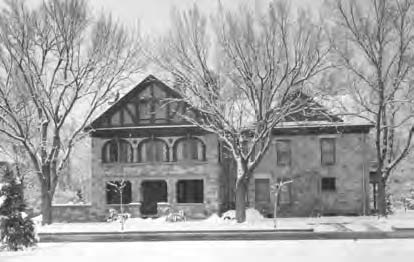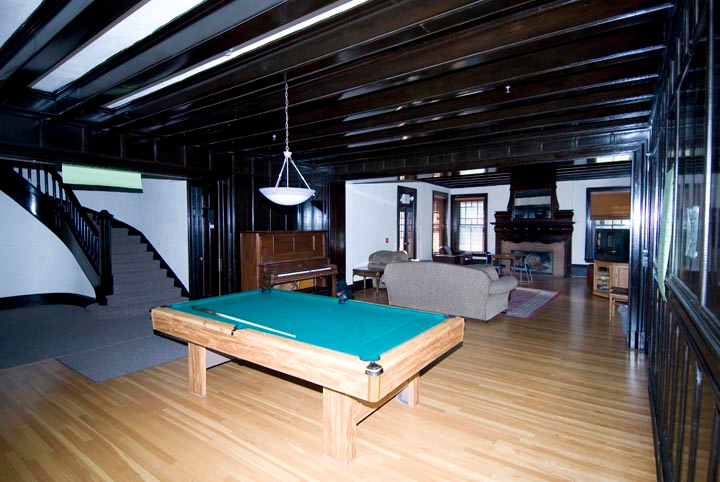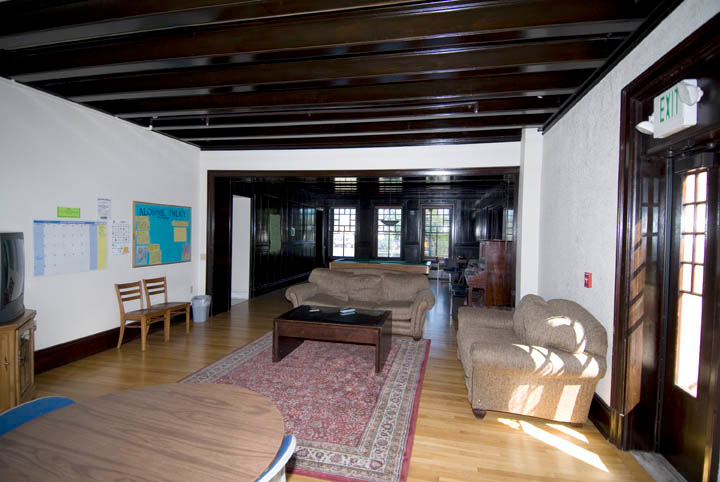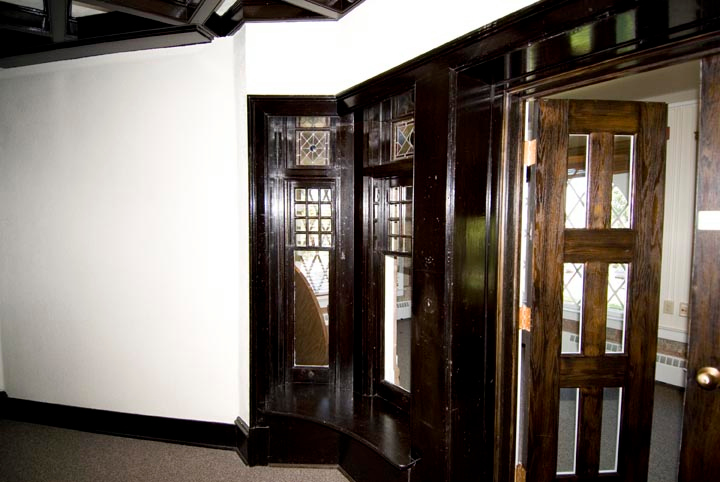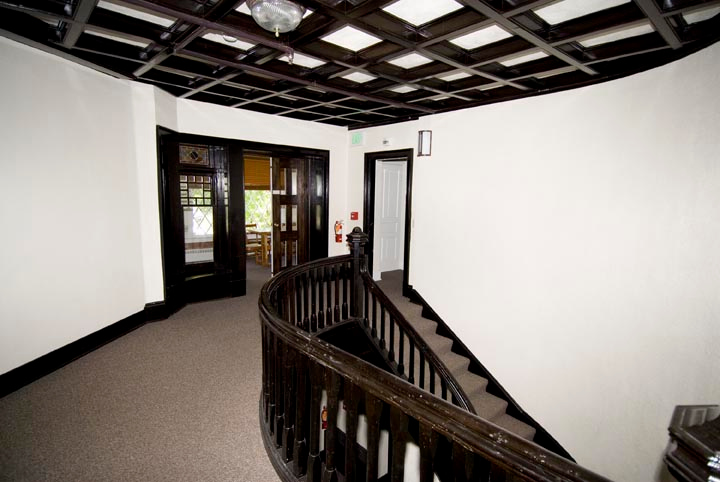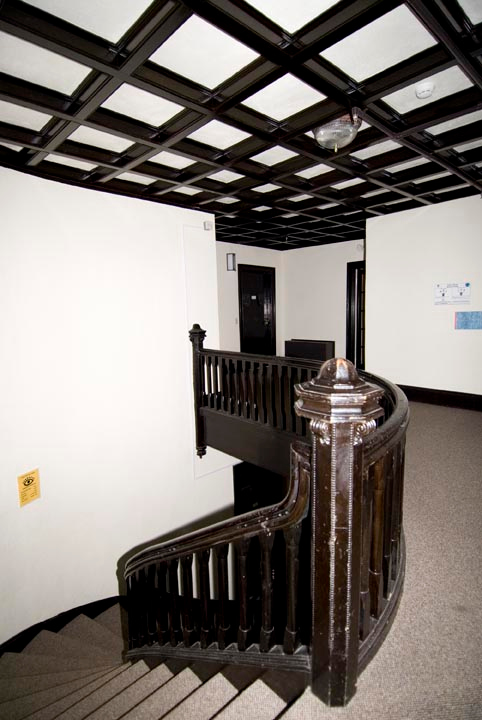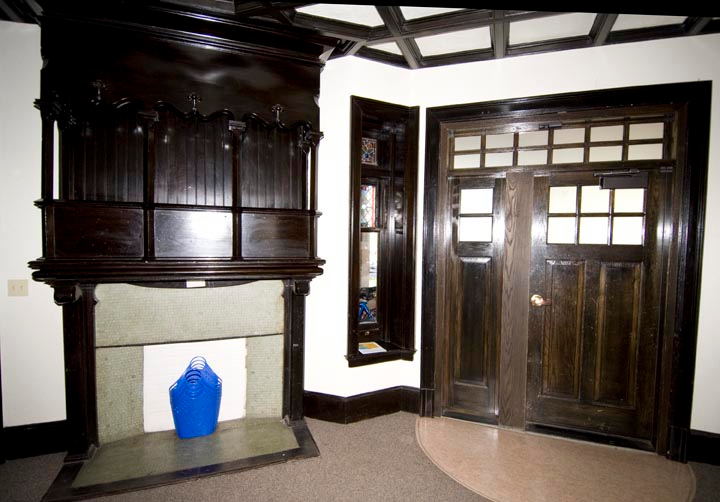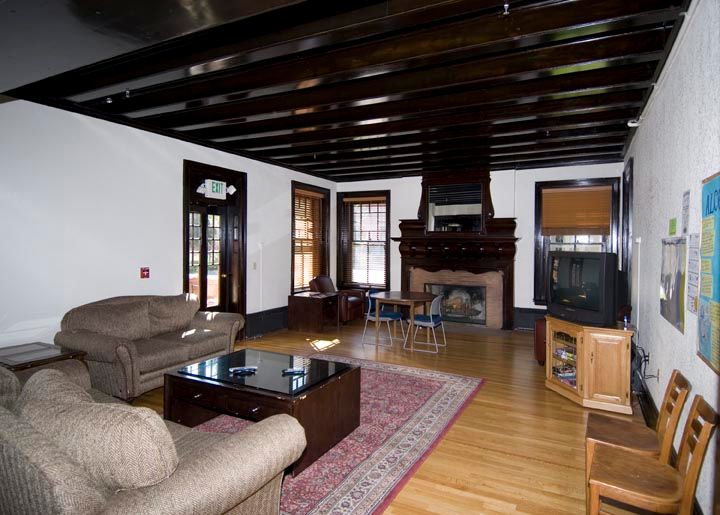Arthur House
Tour Stop: #9
Current Name: Arthur House
Historic Name: Edgeplain, Bass House, Arthur House
Address: 1106 N. Nevada Avenue
Year Completed: 1881
Architectural Style: Tudor Revival
Architect: A.C. Willard, Colorado Springs
Designation: National Register
Access Level: Arthur House is a residence and therefore is not open to the public.
Local architect A.C. Willard designed this unusual stone house for Lyman K. and Frances Bass in 1881. The $15,000 Bass residence was noted as one of the significant improvements made to the built environment of Colorado Springs during 1881. The house has remarkable, highly ornamental stone walls consisting of rectangular blocks of multi-hued (white, tan, brown, red, and pink) sandstone of varied width and height laid in broken rangework with tinted mortar. The individual stones display a variety of rusticated dressings, including pecked, vermiculated, rock-faced, frosted, and others.
The Bass family named the house "Edgeplain," for its location at the edge of the undeveloped prairie. A stone inscribed "EDGEPLAIN" is still visible on the south porch of the house near the southeast corner. As one of the first houses built in the vicinity of the college, Edgeplain became an immediate landmark on the landscape. Despite its isolated location, the house included rich paneling, tiled fireplaces, and expensive "jeweled glass" designed by artist John LaFarge. Bass and his wife opened their home to the elite of Colorado Springs. Frances wrote that they hosted "musicians and charming singers who came west for healing sunshine, and in our living-room germinated the society which grew into the foundation of the greatest musical society west of the Mississippi."
Lyman Kidder Bass, born in 1836 in New York, studied law and established a practice in Buffalo that included Grover Cleveland as a partner. Active in Republican Party politics, Bass served as U.S. Representative for New York's 30th Congressional District (1873-77). He married Frances Metcalfe, a beautiful and talented member of a prominent Buffalo family in 1874. In the prime of life, Bass developed tuberculosis and moved to Colorado Springs in an effort to regain his failing health. Colorado attracted many people suffering from respiratory diseases who were searching for the salubrious effects of its dry climate, sunshine, and fresh air. Colorado Springs, in particular, drew a large group of "health seekers who had sufficient property to live in comfort," as early physician Samuel Le Nord Caldwell observed.
Although the state of his health remained uncertain, Lyman Bass became the counsel for General Palmer's Denver and Rio Grande Railroad in Colorado Springs. Frances Bass wrote that her husband was "absorbed" in his work for the D&RG and "it was elation for him to be with those who were state and empire builders." Her husband never completely recovered, however, and he died in May 1889 in New York City. The Buffalo Express eulogized the former Congressman as "one of the great railway counsels of the country."
Following her husband's death, General Palmer assisted Frances Bass in disposing of their Colorado Springs house. Several people owned the house between Bass's death and its purchase in 1901 by Chester Alan Arthur II and his wife, Myra. The son of Chester Alan Arthur, who became President in 1881 following the assassination of James Garfield, Alan Arthur, as he was known, attended Princeton University during his father's administration. The younger Arthur "took full advantage of his position, using the president's private car, yacht and passes whenever possible." He participated in the social affairs and diplomatic receptions in Washington and once staged a White House party for fellow members of the Princeton Glee Club while his father was away.
Newspapers here and abroad cited Alan Arthur as "the Prince of Washington" for his easy manner among the upper echelons of society. He attended law school at Columbia University and planned to take the bar examination in 1886 after a brief European vacation. Instead, his continental sojourn lasted ten years. Alan's son, Chester Alan Arthur III, wrote that his father "was destined to become the perfect pattern of an Edwardian gentleman and of a Europeanized American." He enjoyed a certain prestige based on his status as the son of a former U.S. President, as his own son noted: "He had naturally all the qualities which in that age made what the English called 'a gentleman of leisure.' He was handsome and a sportsman. Women were attracted by him, and men liked him because he was a good shot, rode to the hounds with the best, played an excellent game of billiards and could hold his liquor like a gentleman."
After his May 1900 marriage in Switzerland to Myra Fithian Andrews, a wealthy divorcee, doctors advised Arthur to go to Colorado Springs to seek relief from his bronchitis and asthma. The newlyweds arrived in October 1900, and Alan's health quickly improved in the Colorado sunshine. The Arthurs purchased Edgeplain in 1901 and engaged the architectural firm of Douglas and Hetherington, which had designed residential halls at Colorado College, to remodel and expand the house. The resulting project employed the same stone as the original construction and added Tudor Revival details that made the residence a fitting setting for the couple's extensive calendar of dinners and parties.
The president's son became deeply involved in the social life of the Pikes Peak region, forming friendships with some of the city's most prominent citizens. Arthur served as president of the Cheyenne Mountain Country Club, bringing top polo players to the organization and making the sport a local favorite. Under Arthur's ownership Edgeplain became "one of the outstanding meeting places of the social leaders of Colorado Springs and Denver," according to the Gazette. When Vice President Theodore Roosevelt visited the city in the summer of 1901, he attended a polo match as Arthur's guest and dined at Edgeplain.
In 1922, the Arthurs sold the house for $20,000 (plus $10,000 for the furnishings) to Joseph and Fannie Abraham, who planned to spend summers in the city. Joseph Abraham, an Oklahoma businessman, had interests in real estate, glass manufacturing, and the oil and cotton industries. The Phi Delta Theta fraternity occupied the house during 1926-27. In 1929, John R. and Charlotte Shaver of Montana acquired Edgeplain from Fannie Abraham, Joseph's widow. John Shaver, a founder of the Golden Rule department store at Grants Pass, Oregon, eventually operated a 45-store chain of the businesses in Montana, Washington, Oregon, Idaho, North Dakota, and Minnesota. Shaver sold his interest in the stores to the J.C. Penney Company in 1927 and relocated to Colorado Springs. The Shavers had visited Colorado Springs frequently over the years and attended a party at Edgeplain in 1907. In their new home Charlotte Shaver studied painting under Zola Zaugg of Colorado Springs and became an "avid gardener." John Shaver retired from business affairs in 1943, but the couple continued to reside in the house until their deaths in 1960. Briefly used as a three-unit apartment house, Edgeplain became part of Colorado College in 1962 in a purchase from the daughters of the Shavers.
The college bought the house as "part of a long-range program for acquiring strategic properties bordering on the campus." Rumors that it planned to demolish the house were unfounded. Known as "Arthur House," in a nod to one of its most prominent historic owners, the residence was converted for use as a men's dormitory and later became a coed residence. The house received recognition for its architectural and historical significance through listing in the National Register of Historic Places in 2006.




